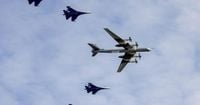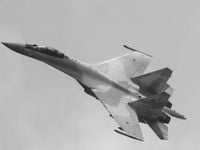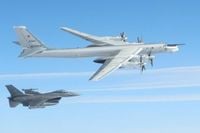On September 24, 2025, the familiar roar of U.S. fighter jets once again echoed over Alaska’s vast, icy expanse. The North American Aerospace Defense Command (NORAD) confirmed that four Russian military aircraft—two Tu-95 long-range strategic bombers and two Su-35 fighter jets—were detected operating in the Alaskan Air Defense Identification Zone (ADIZ). This marked the ninth such encounter this year, underscoring the persistence of these high-stakes aerial cat-and-mouse games along North America’s northern frontier.
According to a NORAD statement cited by The Associated Press, the Russian warplanes were tracked and intercepted by a formidable U.S. contingent: one E-3 Sentry command and control aircraft, four F-16 fighters, and four KC-135 tanker planes. The Russian planes remained in international airspace, never breaching the sovereign airspace of either the U.S. or Canada. NORAD was quick to emphasize that such Russian activity in the ADIZ is not unusual and, crucially, "is not seen as a threat."
But while NORAD may downplay the immediate danger, the steady drumbeat of these encounters is impossible to ignore. As Air & Space Forces Magazine noted, Russian flights into the Alaskan ADIZ have been steadily increasing over recent years: 12 incidents in 2024, eight in 2023, and only two each in 2022 and 2021. The uptick in 2025—nine incidents already before the end of September—reflects a broader pattern of heightened military activity and tension between Russia and Western powers.
The ADIZ itself is a critical, if often misunderstood, buffer zone. As NORAD explained in its statement, it is "a defined stretch of international airspace that requires the ready identification of all aircraft in the interest of national security." While not sovereign airspace, the ADIZ is closely monitored, and any unidentified or unresponsive aircraft are quickly met by interceptors. This system is designed to provide early warning and prevent any surprises—a legacy of Cold War vigilance that remains just as relevant today.
These latest Russian flights come at a time of escalating tensions across Europe and the North Atlantic. On September 10, 2025, NATO fighter jets shot down Russian drones that had crossed into Polish airspace, marking the first time the alliance has used force against Russian aircraft to defend NATO airspace. Shortly after, Estonia reported several Russian fighter jets entering its airspace, and the Baltic Sea has seen an uptick in both manned and unmanned Russian incursions. In response, NATO launched Operation Eastern Sentry, a new initiative to bolster defenses along its eastern border with Russia.
European leaders have been vocal about their willingness to respond more forcefully to these provocations. During a CNN appearance on September 24, European Commission President Ursula von der Leyen stated, "My opinion is we have to defend every square centimeter of territory, and that means if there’s an intrusion in the airspace, after warning, after being very clear, of course, the option of shooting down a fighter jet that is intruding our airspace is on the table." Her comments echo a growing consensus among NATO countries that deterrence must be credible and visible.
President Donald Trump, during a meeting with Ukrainian President Volodymyr Zelensky at the United Nations General Assembly on September 24, also weighed in. He told reporters that NATO countries should shoot down Russian jets that enter their airspace. When pressed on whether the U.S. would support such actions, Trump replied, "it depends on the circumstance." The former president’s remarks highlight the complex calculus facing Western leaders as they attempt to balance deterrence with the risk of escalation.
Back in Alaska, NORAD’s response was swift and by the book. As The Washington Times described, the E-3 Sentry, four F-16s, and four KC-135 tankers were scrambled to "positively identify and intercept" the Russian aircraft. The Russian planes, for their part, did not attempt to hide, but neither did they stray into restricted territory. This choreography—a dance of approach, identification, and withdrawal—has become almost routine. "NORAD remains ready to employ a number of response options in defense of North America," the command stated, underscoring its layered defense network of satellites, radars, and fighter aircraft.
Yet, there is little doubt that these encounters serve a dual purpose. As experts told Air & Space Forces Magazine, the string of Russian flights in August—four incursions in six days, including an Il-20 COOT electronic intelligence aircraft—was likely an effort to gather intelligence on the U.S. Indo-Pacific Command’s large-scale exercise Northern Edge. These flights, while not seen as a direct threat to the U.S. homeland, are widely interpreted as attempts to probe U.S. and NATO readiness, test response times, and collect valuable data on Western military operations.
It’s not just Alaska feeling the pressure. Across Europe, a series of incidents has kept defense officials on edge. On September 23 and 24, large, unidentified drones disrupted air traffic near Copenhagen Airport, prompting an investigation by Danish police, who described the operators as a "capable actor." In late August, NORAD detected and tracked a Russian reconnaissance aircraft in the Alaskan ADIZ, part of a pattern stretching back months. And in September 2024, a Russian jet flew within just a few feet of NORAD aircraft off Alaska’s coast—a maneuver the U.S. military described as "unsafe, unprofessional, and endangered all."
Despite the frequency of these encounters, NORAD has consistently maintained that Russian military activity in the ADIZ is common and not considered a direct threat. "The Russian military aircraft remained in international airspace and did not enter American or Canadian sovereign airspace. This Russian activity in the Alaskan ADIZ occurs regularly and is not seen as a threat," NORAD reiterated in its latest statement. Still, the context—Russia’s ongoing war in Ukraine, NATO’s heightened alertness, and the steady stream of airspace violations—suggests that these flights are more than mere routine. They are signals, both to Western militaries and to domestic audiences in Russia, that the game of brinkmanship continues.
For now, the skies over Alaska remain contested but controlled. Each new encounter is a reminder of the delicate balance that defines modern air defense: vigilance without provocation, readiness without panic. As NORAD’s layered network stands watch, the world watches too—hoping that the next intercept remains just another routine day at the edge of the Arctic.



